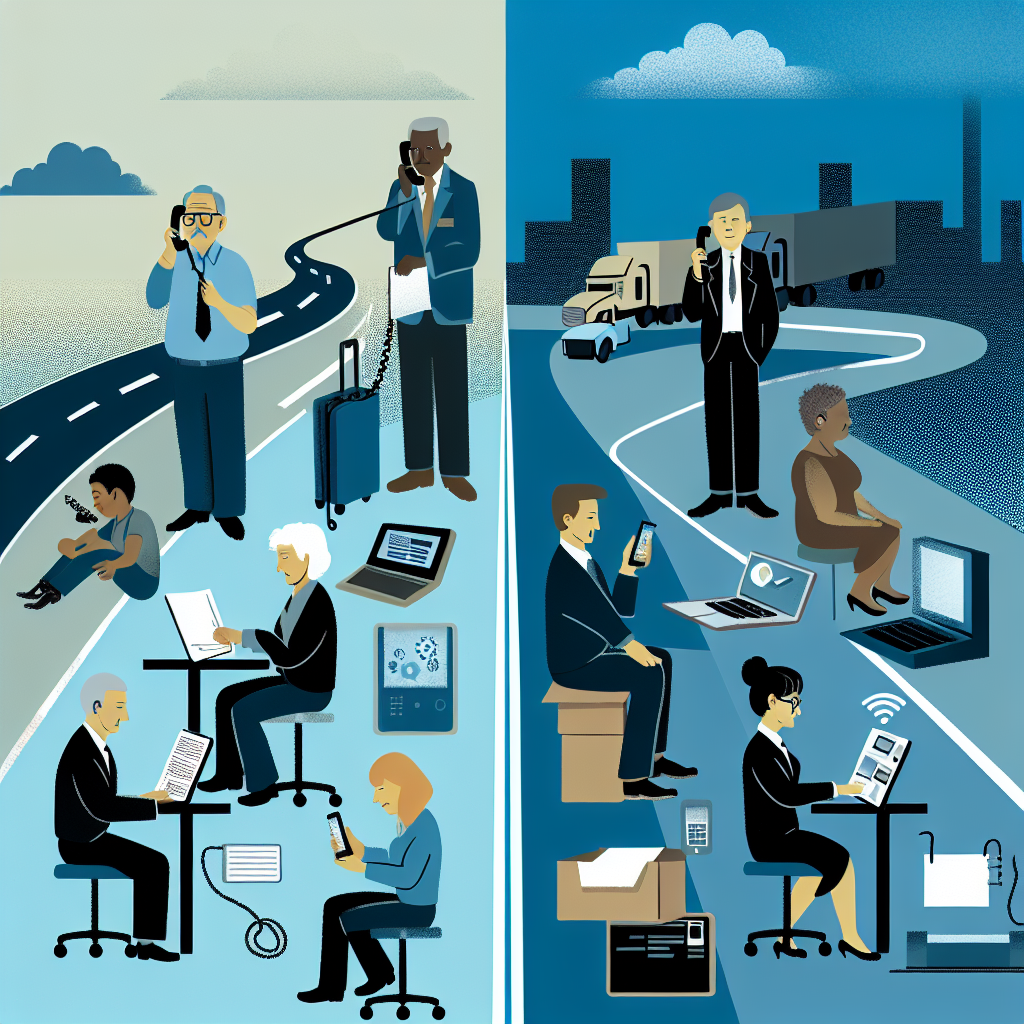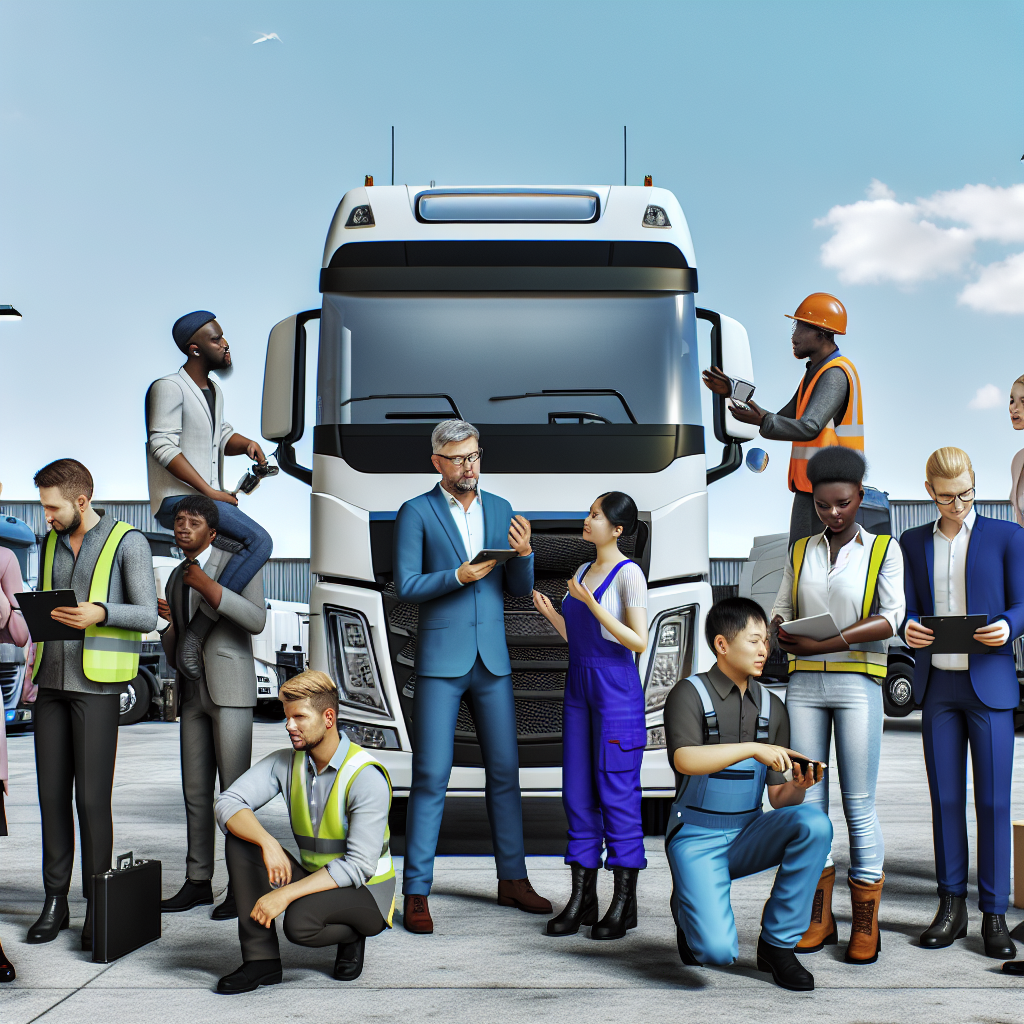In the changing trucking industry, digital innovations are reshaping fleet operations. As companies adopt new technologies, it is essential not to overlook the people behind the wheels. A balance between cutting-edge tools and investing in employees is crucial for a thriving workforce culture and improved operational efficiency. With generational shifts in workforce expectations, companies that value employees alongside technology will foster loyalty and satisfaction, leading to lasting success. Voices within the industry call for a thoughtful investment approach, highlighting that culture and training are as vital as the latest digital solutions. The path forward requires blending innovation with a commitment to people-focused strategies.
Challenges of Adopting Digital Tools in Trucking
The trucking industry faces unique challenges when incorporating digital tools. One major issue is the generational divide among workers. Experienced truck drivers rely on traditional practices and may resist new technologies. David Kelly expresses this feeling, saying, “Some just don’t want to use digital tools.” Such resistance can limit a fleet’s ability to fully utilize automation and digital management systems.
On the other hand, younger employees are more open to technology. However, they also seek work-life balance and flexible schedules, contrasting with the long hours typical in trucking. Companies must rethink strategies to attract and keep new drivers.
Moreover, not all customers prefer digital communication; about 30% still favor phone calls. This shows a slower transition to complete digital channels and reflects mixed preferences among drivers and clients.
Training also presents challenges. While automation can cut training time from weeks to hours, investing in solid training programs is essential. Companies need to integrate new technologies while ensuring support for their drivers and staff. As Jason Belgrave said, automation should focus on redeploying talent into more valuable work, rather than just cost-cutting.
Lastly, fostering a culture that can adapt to change is necessary. Gary Vandenheuvel highlights that the industry must evolve with current demands. “We can’t just say, ‘Do what we did.’ We have to adapt,” he states, reinforcing the need for a dynamic corporate culture.
Case Study: Paper Transport
One trucking company that successfully combined digital innovation with a people-focused approach is Paper Transport, based in Green Bay, Wisconsin. They operate 850 trucks and have embraced various technological advancements to enhance driver engagement and productivity.
Approaches:
- Tablets with Fleet Management Systems: Paper Transport gave drivers tablets with the XRS mobile fleet management system from Omnitracs. This lets drivers access important information on the go.
- Driver Scorecard App: The company created an app for drivers to track their performance daily, view rankings, and monitor progress towards monthly rewards.
- Online Training Platform: By using Luma’s online training platform, Paper Transport expanded training beyond initial orientation, offering continuous learning.
- Trip Planning App (SmartETA): The app factors in Hours of Service, providing simulated trip plans with arrival times, fuel stops, and required rest breaks.
Outcomes:
- Improved Driver Engagement: The driver scorecard app and ongoing training boosted driver motivation.
- Lower Turnover Rates: The online training platform significantly cut driver turnover in the first 90 days.
- Increased Productivity: SmartETA streamlined trip planning, improving productivity.
By using these digital tools, Paper Transport enhanced operational efficiency while prioritizing employee engagement and satisfaction, showing a successful balance between technological innovation and a people-centric strategy.
Culture Building in Trucking
Building a strong culture in trucking fleets is essential for employee satisfaction and retention. Company culture reflects how employees are valued and how technology is used daily. A positive culture boosts motivation and loyalty, reducing turnover. A recent WorkHound report shows 24% of positive feedback occurs from recognition, highlighting the role of appreciation in job satisfaction.
To develop a strong culture, trucking companies should encourage open communication between management and drivers. Transparency about policies fosters trust and creates a supporting environment, crucial for high retention. Studies show that open communication leads to better engagement outcomes.
Investing in professional development is also key for building culture. Offering training and clear advancement paths reinforces commitment to employees, significantly lessening turnover. Promoting work-life balance through flexible schedules meets drivers’ needs for predictable home time and job satisfaction.
Creating a culture of respect and inclusion further enhances employee value. Forbes notes that employees who feel respected are more likely to stay with their employers, underscoring the importance of a positive workplace culture.
Integrating technology effectively within this culture makes a strong impact. For example, using telematics and fleet management systems improves efficiency and empowers drivers, making their roles easier. Combining technology with human skills fosters an environment where employees feel supported. The focus on both culture and technology allows trucking companies to create a strong workforce, leading to lasting success.
Conclusion
In conclusion, the trucking industry faces a critical moment where balancing digital innovation and people-focused strategies is essential. As discussed, integrating technology enhances efficiency, but investing in human capital remains vital.
Insights from industry leaders stress the importance of creating a culture that embraces change, rewards adaptability, and acknowledges diverse preferences among employees and customers. Companies must recognize that automation and digital tools offer advantages, but it is the people who truly drive these advancements. The case of Paper Transport illustrates how merging technology with meaningful training can lead to success while ensuring the workforce feels valued.
Trucking executives should develop actionable takeaways that connect with their teams. This includes fostering open communication, providing career advancement paths, and promoting work-life balance as younger generations enter the workforce. Ultimately, organizations that prioritize technology and a commitment to their employees will thrive in an evolving marketplace.
The future of trucking hinges on focusing on digital innovations and nurturing today’s talent. By doing so, fleets can create a resilient, engaged workforce ready for future challenges and opportunities.
Challenges of Adopting Digital Tools in Trucking
The trucking industry encounters a unique set of challenges when integrating digital tools into its operations. A significant factor is the generational divide within the workforce. Many seasoned truck drivers have built their careers on traditional practices and may resist adapting to new digital technologies. David Kelly captures this sentiment, stating, “Some just don’t want to use digital tools.” This resistance can hinder a fleet’s ability to fully leverage the advantages offered by automation and digital management systems.
Conversely, younger employees display a propensity for embracing technology. However, they are also increasingly seeking work-life balance and opportunities for flexible scheduling that stand in contrast to the long hours historically associated with trucking. This expectation creates a complex environment where companies need to rethink their operational strategies to attract and retain the new generation of drivers.
Moreover, the statistics reveal a notable preference among customers; about 30% still favor phone calls for communication over digital solutions, suggesting a broader hesitance to move completely to digital channels. This phenomenon not only indicates the dual nature of preferences among drivers and clients but also suggests that the transition to a more technological infrastructure may be gradual rather than immediate.
Training also presents a significant challenge. While automating and digitalizing processes can reduce training time from weeks to hours, the initial investment in well-structured training programs remains critical. Companies must focus on integrating these new technologies seamlessly while ensuring that their drivers and staff feel supported and equipped to handle the tools. As Jason Belgrave pointed out, the first instinct may be to see automation solely as a cost-cutting measure, but it is essential to consider it a means of redeploying talent into higher-value work.
Lastly, cultivating a culture that adapts to change is vital. Gary Vandenheuvel emphasizes that the industry must not merely cling to past methods but instead evolve to meet current demands. “We can’t just say, ‘Do what we did.’ We have to adapt,” he said, reinforcing the need for a dynamic corporate ethos.

Case Study: Paper Transport
One notable example of a trucking company that successfully balanced digital innovation with a people-focused strategy is Paper Transport. This Green Bay, Wisconsin-based fleet, operating 850 trucks, implemented several technological advancements to enhance driver engagement and productivity.
Approaches:
- Deployment of Tablets with Fleet Management Systems: Paper Transport equipped drivers with tablets running the XRS mobile fleet management system from Omnitracs. This provided drivers with portable access to essential information and applications.
- Driver Scorecard Application: The company developed an app that allows drivers to review daily performance metrics across various categories, see their rankings, and track progress toward monthly rewards.
- Online Training Platform: Utilizing Luma’s online training platform, Paper Transport extended training beyond initial orientation, offering continuous learning opportunities.
- Proprietary Trip Planning App (SmartETA): This application accounts for drivers’ Hours of Service, providing simulated trip plans on digital maps that include arrival times, fuel stops, and mandated rest breaks.
Outcomes:
- Enhanced Driver Engagement: The driver scorecard app and continuous training opportunities have led to increased driver engagement and motivation.
- Reduced Turnover: The online training platform contributed to a significant reduction in driver turnover during the initial 90-day period.
- Improved Productivity: The SmartETA app streamlined trip planning, reducing the learning curve and enhancing overall productivity.
By integrating these digital tools, Paper Transport not only improved operational efficiency but also prioritized driver engagement and satisfaction, demonstrating a successful balance between technological innovation and a people-centric approach.
| Training Method | Efficiency | Training Time | Employee Feedback |
|---|---|---|---|
| Traditional Methods | Slower adoption of skills | Weeks to complete | Varied; some prefer hands-on |
| Automated Methods | Rapid skills acquisition | Reduced to hours | Generally positive; prefers tech |
Culture Building in Trucking
Building a strong culture within trucking fleets is essential for enhancing employee satisfaction and retention. The culture of a company is reflected in how it values its employees and integrates technology into daily operations. A positive company culture boosts motivation and loyalty among drivers, making them less likely to leave for other opportunities. In fact, a recent WorkHound report highlighted that 24% of positive feedback from drivers resulted from recognition and praise, underscoring the importance of appreciation in job satisfaction source.
To cultivate such a culture, trucking companies should focus on transparent communication between management and drivers. Honesty about policies and business performance fosters trust and creates a supportive environment, which is critical for high retention rates. A study showed that organizations that communicate openly achieve better outcomes in employee engagement source.
Professional development opportunities also play a significant role in building a strong culture. By investing in training and providing clear paths for advancement, companies affirm their commitment to their employees’ future, which can substantially reduce turnover source. Furthermore, promoting a work-life balance through flexible scheduling answers the need for predictability in drivers’ home time and job satisfaction source.
Additionally, a culture that emphasizes respect and inclusion reinforces employee value. According to a Forbes article, employees who feel respected are significantly more likely to remain with their employer, highlighting the necessity of nurturing a positive workplace culture source.
Integrating technology effectively into this cultural framework creates a synergistic effect. For instance, the deployment of telematics and modern fleet management systems not only enhances efficiency but also empowers drivers by making their roles easier and more fulfilling. When technology complements human skills, it helps build an environment where employees feel supported and equipped to excel. This dual focus on culture and technology thus allows trucking companies to establish a robust workforce, leading to sustainable success in the industry.
Conclusion
In conclusion, the trucking industry stands at a pivotal juncture where balancing digital innovation with people-focused strategies is not merely beneficial; it is essential for future success. As we have discussed, while the integration of advanced technology can enhance operational efficiency, the emphasis on investing in human capital remains paramount.
Key insights shared by industry leaders highlight the importance of creating a culture that embraces change, rewarding adaptability, and respecting the diverse preferences of both employees and customers. Companies must recognize that while automation and digital tools provide significant advantages, it is the people who drive these advancements that underscore the industry’s ethos. For instance, the dual adoption of technology and meaningful training, as illustrated in the case of Paper Transport, exemplifies how companies can ride the wave of digital transformation while ensuring their workforce feels valued and engaged.
Moreover, trucking executives are encouraged to develop actionable takeaways that resonate with their teams. This includes fostering open communication, providing clear paths for career advancement, and emphasizing work-life balance as younger generations enter the workforce. Ultimately, organizations that prioritize a seamless integration of technology with a commitment to their personnel are the ones poised to thrive in an ever-evolving marketplace.
The future of trucking relies on a dual focus: embracing the innovations of tomorrow while nurturing the talent of today. By doing so, fleets can cultivate a resilient, engaged workforce ready to meet the challenges and opportunities that lie ahead.
User Adoption Data in Digital Tools for Trucking Fleets
Recent data highlights significant generational differences in the adoption and preferences for digital tools within the trucking industry:
- Gen Z Operators Reshaping the Workforce: As of 2025, Gen Z operators now constitute 28% of the dump truck workforce, a 15% increase from 2024. This demographic shift brings new perspectives and tech-savvy approaches to traditional operations. Notably, 73% of Gen Z operators demonstrate higher proficiency in digital fleet management systems, and a striking 89% prefer mobile-first communication and scheduling platforms. This indicates a clear shift towards digital adoption as they enter the workforce.
- Digital Onboarding Preferences: A significant 78% of drivers now prefer digital onboarding processes over traditional paperwork. This trend illustrates a strong inclination towards digital solutions among newer generations in the industry, further reinforcing the need for companies to adapt their onboarding strategies to appeal to tech-savvy drivers.
- Mobile App Utilization: Approximately 55% of drivers utilize mobile apps for essential functions like document capture, routing, and reporting. This reflects a growing reliance on mobile technology for operational efficiency, particularly among younger drivers who are accustomed to such tools in their personal and work lives.
- Digital Training Adoption: Virtual reality (VR) and augmented reality (AR) tools are gradually being adopted for driver training, with 23% of fleets implementing these solutions. These innovative training methods not only engage younger drivers but also facilitate quicker skill acquisition through immersive learning experiences.
These statistics underscore a generational shift in the trucking industry towards digital tool adoption, highlighting that younger drivers exhibit a stronger preference and proficiency for utilizing these technologies compared to their older counterparts. This insight points to the necessity for trucking companies to embrace modernization while remaining sensitive to the varying needs and capabilities of their multi-generational workforce.
User Adoption Data Links in Digital Tools for Trucking Fleets
Recent data highlights significant generational differences in the adoption and preferences for digital tools within the trucking industry:
- Gen Z Operators Reshaping the Workforce: As of 2025, Gen Z operators now constitute 28% of the dump truck workforce, a 15% increase from 2024. This demographic shift brings new perspectives and tech-savvy approaches to traditional operations. Notably, 73% of Gen Z operators demonstrate higher proficiency in digital fleet management systems, and a striking 89% prefer mobile-first communication and scheduling platforms. This indicates a clear shift towards digital adoption as they enter the workforce. [Source]
- Digital Onboarding Preferences: A significant 78% of drivers now prefer digital onboarding processes over traditional paperwork. This trend illustrates a strong inclination towards digital solutions among newer generations in the industry, further reinforcing the need for companies to adapt their onboarding strategies to appeal to tech-savvy drivers. [Source]
- Mobile App Utilization: Approximately 55% of drivers utilize mobile apps for essential functions like document capture, routing, and reporting. This reflects a growing reliance on mobile technology for operational efficiency, particularly among younger drivers who are accustomed to such tools in their personal and work lives. [Source]
- Digital Training Adoption: Virtual reality (VR) and augmented reality (AR) tools are gradually being adopted for driver training, with 23% of fleets implementing these solutions. These innovative training methods not only engage younger drivers but also facilitate quicker skill acquisition through immersive learning experiences. [Source]
These statistics underscore a generational shift in the trucking industry towards digital tool adoption, highlighting that younger drivers exhibit a stronger preference and proficiency for utilizing these technologies compared to their older counterparts. This insight points to the necessity for trucking companies to embrace modernization while remaining sensitive to the varying needs and capabilities of their multi-generational workforce.

| Generation | Percentage Using Digital Tools | Preferred Communication Method | Onboarding Preference | Mobile App Utilization |
|---|---|---|---|---|
| Gen Z | 73% | Mobile-first | 78% | 55% |
| Millennials | 65% | Text messaging | 65% | 50% |
| Gen X | 50% | 45% | 30% | |
| Baby Boomers | 30% | Phone calls | 20% | 15% |
This table summarizes the key statistics regarding user adoption of digital tools across different generations within the trucking industry, emphasizing the shift towards technology use, communication preferences, and onboarding processes.

